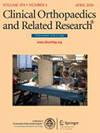Are the Clinical Outcomes of Lumbar Stenosis in Achondroplasia Associated With the Severity of Stenosis and Sagittal Balance?
IF 4.4
2区 医学
Q1 ORTHOPEDICS
引用次数: 0
Abstract
BACKGROUND Lumbar spinal stenosis (LSS) is common in adults with achondroplasia and predisposes individuals to neurogenic claudication. It remains unverified whether the severity of stenosis in patients with achondroplasia is associated with clinical outcomes. Similarly, the role of sagittal balance parameters in clinical outcomes has not been determined. QUESTIONS/PURPOSES (1) Is the severity of LSS associated with the clinical outcomes of patients with achondroplasia who have LSS? (2) Are sagittal balance parameters associated with the clinical outcomes of LSS in patients with achondroplasia? (3) Is the combination of severe LSS and pathologic thoracolumbar kyphosis associated with worse clinical outcomes? METHODS Over the past decade, 102 patients with achondroplasia visited the neurosurgical outpatient clinic because of neurogenic claudication. After excluding seven patients because of the absence of lumbar MRI scans, 95 patients were deemed eligible for the study. Of these patients evaluated, 45 completed the survey and were included. Among them, 32 underwent surgical decompression because of the combination of the severity of their clinical presentation and the relevant stenosis on MRI. The median (range) follow-up time was 4.8 years (0.7 to 12.4). This study sought to examine the relationship between clinical outcomes and radiologic findings, so the follow-up duration is measured from the date of radiologic screening to the date of the follow-up response. To more accurately reflect the association, a shorter follow-up period is desirable, minimizing the impact of time delays and allowing for a more immediate evaluation of the relationship. The median (range) ages of the nonsurgical and surgical groups were 55 years (22 to 66) and 55 years (23 to 88), respectively. In the nonsurgical group, 54% (7 of 13) were men, and in the surgical group, 28% (9 of 32) were men. Surveys were distributed to 95 patients whose lumbar MRIs were available, and the follow-up questionnaires included the Oswestry Disability Index, VAS, EQ-5D, modified Japanese Orthopaedic Association (mJOA) scale, and the Hospital Anxiety and Depression Scale. MRI findings (Schizas grades [a visual classification based on the relationship between the dural sac and nerve roots, ranging from grade A (normal or mild stenosis) to grade D (severe stenosis)] and dural sac cross-sectional area [DSCA]) and sagittal balance parameters (thoracolumbar kyphosis, lumbar lordosis, and sagittal vertical axis) were evaluated using standing lateral radiographs. Associations between clinical and radiologic parameters were investigated by linear regression. RESULTS With the numbers of patients available, we observed no association between the severity of LSS and clinical outcome as assessed by the tools we used. We also observed that thoracolumbar kyphosis was the sole radiologic finding associated with the clinical outcomes measured by the EQ-5D index scores (B = -0.01 [95% confidence interval (CI) -0.01 to -0.002]; p = 0.003); while the coefficient of -0.01 per degree might appear small, a 20° thoracolumbar kyphosis was widely observed in patients with achondroplasia and was associated with a 0.2 decrease in the EQ-5D index score-a substantial reduction, given that the EQ-5D index ranges between 0 and 1. When we considered thoracolumbar kyphosis and degree of stenosis, we found that patients with achondroplasia and severe stenosis (DSCA < 62 mm2) and pathologic thoracolumbar kyphosis (> 20°) demonstrated worse functionality as quantified by mJOA scores (median [range] 11 [9 to 17] versus 16 [6 to 18]; p = 0.046). After controlling for confounding factors, pathologic thoracolumbar kyphosis and smaller DSCA were also associated with worse clinical outcomes as quantified by mJOA scores (B = -2.56 [95% CI -4.52 to -0.60]; p = 0.01), which can be interpreted as a 3-point lower (worse) score on an 18-point scale in those individuals. CONCLUSION In adult patients with achondroplasia experiencing from neurogenic claudication, thoracolumbar kyphosis is associated with worse functional outcomes as quantified by EQ-5D, and when in combination with severe stenosis, it is associated with less favorable mJOA scores. Controlling thoracolumbar kyphosis at an early age in a nonsurgical way may benefit patients. Larger cohorts of patients with prospectively collected data and long-term follow-up are needed to confirm whether early nonsurgical treatment to prevent the progression of thoracolumbar kyphosis can improve long-term clinical outcomes. Despite the limitations of an observational study, the current data stress the importance of maintaining thoracolumbar kyphosis within appropriate limits. LEVEL OF EVIDENCE Level III, therapeutic study.软骨发育不全腰椎管狭窄的临床结果与狭窄的严重程度和矢状平衡有关吗?
背景:腰椎管狭窄症(LSS)在软骨发育不全的成年人中很常见,并且容易使个体发生神经源性跛行。软骨发育不全患者狭窄的严重程度是否与临床结果相关仍未得到证实。同样,矢状面平衡参数在临床结果中的作用尚未确定。问题/目的(1)软骨发育不全患者LSS的严重程度是否与LSS的临床结局相关?(2)矢状面平衡参数是否与软骨发育不全患者LSS的临床结局相关?(3)重度LSS合并病理性胸腰椎后凸是否与较差的临床预后相关?方法近十年来,102例软骨发育不全患者因神经源性跛行就诊神经外科门诊。由于缺少腰椎MRI扫描,在排除了7名患者后,95名患者被认为符合研究条件。在这些被评估的患者中,有45人完成了调查并被纳入。其中32例由于临床表现的严重程度和MRI上的相关狭窄,接受了手术减压。中位(范围)随访时间为4.8年(0.7 - 12.4年)。本研究旨在研究临床结果与放射学结果之间的关系,因此随访时间从放射学筛查之日起至随访反应之日止。为了更准确地反映这种联系,需要更短的随访时间,以尽量减少时间延迟的影响,并允许对这种关系进行更直接的评估。非手术组和手术组的年龄中位数(范围)分别为55岁(22 ~ 66岁)和55岁(23 ~ 88岁)。在非手术组中,54%(13人中有7人)为男性,而在手术组中,28%(32人中有9人)为男性。对95例获得腰椎mri的患者进行调查,随访问卷包括Oswestry残疾指数、VAS、eg - 5d、修正日本骨科协会(mJOA)量表和医院焦虑抑郁量表。MRI表现(Schizas分级[基于硬脊膜囊和神经根之间关系的视觉分类,从a级(正常或轻度狭窄)到D级(严重狭窄)]和硬脊膜囊横截面积[DSCA])和矢状平衡参数(胸腰椎后凸、腰椎前凸和矢状垂直轴)通过站立侧位x线片进行评估。通过线性回归研究临床和放射学参数之间的关系。根据可用的患者数量,我们观察到LSS的严重程度与我们使用的工具评估的临床结果之间没有关联。我们还观察到胸腰椎后凸是与EQ-5D指数评分测量的临床结果相关的唯一影像学表现(B = -0.01[95%可信区间(CI) -0.01至-0.002];P = 0.003);虽然每度-0.01的系数可能看起来很小,但在软骨发育不全患者中广泛观察到20°胸腰椎后凸,并与EQ-5D指数评分降低0.2有关-考虑到EQ-5D指数范围在0到1之间,这是一个实质性的降低。当我们考虑胸腰椎后凸和狭窄程度时,我们发现软骨发育不全和严重狭窄(DSCA < 62 mm2)和病理性胸腰椎后凸(bbb20°)的患者表现出更差的功能,mJOA评分量化(中位数[范围]11[9至17]对16[6至18];p = 0.046)。在控制混杂因素后,病理性胸腰椎后凸和较小的DSCA也与mJOA评分量化的较差临床结果相关(B = -2.56 [95% CI -4.52至-0.60];p = 0.01),这可以解释为这些个体在18分制中得分低3分(较差)。结论:在神经源性跛行伴软骨发育不全的成年患者中,EQ-5D量化的胸腰椎后凸与较差的功能预后相关,当合并严重狭窄时,与较差的mJOA评分相关。在早期以非手术方式控制胸腰椎后凸可能对患者有益。需要更大的患者队列,前瞻性收集数据和长期随访,以确认早期非手术治疗预防胸腰椎后凸的进展是否可以改善长期临床结果。尽管观察性研究存在局限性,但目前的数据强调了将胸腰椎后凸保持在适当范围内的重要性。证据等级:III级,治疗性研究。
本文章由计算机程序翻译,如有差异,请以英文原文为准。
求助全文
约1分钟内获得全文
求助全文
来源期刊
CiteScore
7.00
自引率
11.90%
发文量
722
审稿时长
2.5 months
期刊介绍:
Clinical Orthopaedics and Related Research® is a leading peer-reviewed journal devoted to the dissemination of new and important orthopaedic knowledge.
CORR® brings readers the latest clinical and basic research, along with columns, commentaries, and interviews with authors.

 求助内容:
求助内容: 应助结果提醒方式:
应助结果提醒方式:


